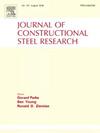Confinement mechanism of angle steel-corrugated steel plate confined concrete columns under compression
IF 4
2区 工程技术
Q1 CONSTRUCTION & BUILDING TECHNOLOGY
引用次数: 0
Abstract
To enhance steel efficiency and reduce energy consumption in construction, a novel angle steel-corrugated steel plate confined concrete (A-CSC) column has been developed. This composite column is constructed by welding outward-facing angle steel at the corners to side corrugated steel plates, with the core filled with concrete. The angle steel primarily carries axial loads, whereas the corrugated steel plates offer confinement to the concrete and bear shear forces. This study investigates the axial compression behavior of these composite columns through experiments and finite element method (FEM) analyses. The findings indicate that the corrugated steel plates effectively confine the concrete without experiencing local buckling before the columns reach their peak load, even when the corrugated steel plate has a large width-to-thickness ratio. Based on the experimental data, load-axial strain curves for each component were derived using an internal force decomposition method. Subsequently, a constitutive model was proposed for the concrete confined by the corrugated steel plates in fiber model. Finally, an equivalent cross-section analysis was conducted to develop a load-bearing capacity calculation formula applicable to components with varying sectional depth-width ratios.
求助全文
约1分钟内获得全文
求助全文
来源期刊

Journal of Constructional Steel Research
工程技术-工程:土木
CiteScore
7.90
自引率
19.50%
发文量
550
审稿时长
46 days
期刊介绍:
The Journal of Constructional Steel Research provides an international forum for the presentation and discussion of the latest developments in structural steel research and their applications. It is aimed not only at researchers but also at those likely to be most affected by research results, i.e. designers and fabricators. Original papers of a high standard dealing with all aspects of steel research including theoretical and experimental research on elements, assemblages, connection and material properties are considered for publication.
 求助内容:
求助内容: 应助结果提醒方式:
应助结果提醒方式:


